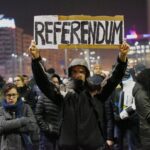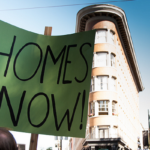What is happening in the Arctic?

Although the Arctic is in perpetual darkness in the depths of winter, temperatures have soared during January and February 2018.
An astounding nine days in February reached temperatures above zero at the Cape Morris Jesup weather station in northern Greenland, with a maximum of 6.2°C on the 24th February, approximately 39°C above the average February temperature.
Temperatures in northern Greenland have been above freezing for 61 hours during February – more than three times the number of hours in any previous year. Although temporary temperature spikes in the Arctic can occur and have been recorded as early as 1896, this event is so unusual because of its intensity and duration.
The extreme heat has caused shrinkage of sea ice when it should be growing over the winter. For example, sea ice set a new record low for January at 13.06 million square kilometres, which is 9.4% below the 1981-2010 average – equivalent to the area of the Northern Territory in Australia.
This broke the previous record set in 2017, with a low of 13.17 million square kilometres of sea ice, which broke the previous record set in 2016, equal to 2006. Sea ice extent was also the smallest on record for February, 8.8% below the 1981-2010 average.
Meanwhile, temperatures further south in the northern hemisphere winter plummeted, bringing blizzards and freezing conditions across the European continent. Snow even made a brief appearance in Rome.
At least 50 deaths have been linked to the cold conditions in Europe, with as many as 21 deaths occurring in Poland alone. In the UK, the freezing weather cost its economy £1bn a day, which is expected to halve GDP growth for the first three months of the year.
Why is this happening?
The extreme warming in the Arctic and the freezing conditions across Europe are due to the same phenomenon – a temporary weakening and splitting of the polar vortex.
This is a circle of winds around the Arctic, roughly 8 km above the Earth’s surface, that help to deflect warm air masses away from the Arctic and cold air masses away from Europe and North America.
If the polar vortex weakens, ‘kinks’ can develop, resulting in weather disruptions across the northern hemisphere, when masses of cold Arctic air are pushed south, while masses of warm air are pushed north.
Scientists suspect that climate change may have an influence on this phenomenon through declining sea ice extent linked to warmer Arctic temperatures.
Winter warming in the Arctic can occur without climate change and there are recorded events stretching back as early as 1896, but now warming events are increasing in frequency and duration.
During the past four winters – 2015 to 2018 – extreme warming events were observed with temperatures approaching or exceeding 0°C. This is a remarkable departure from normal conditions when winter temperatures in the Arctic are typically below -30°C.
How is climate change influencing the polar vortex and Arctic warming?
The strength of the polar vortex depends on the temperature differential between the Arctic and the northern mid-latitudes – the temperate region between the Arctic and the Tropics.
One recent study found that declining sea ice extent in the Arctic from November-December over the Barents-Kara seas weakens the polar vortex during mid-winter, allowing warm air to penetrate into the Arctic from the mid latitudes.
As a consequence of climate change, the Arctic is warming much faster than the global average temperature, so the temperature differential between the Arctic and the mid-latitudes is shrinking.
This phenomenon is known as ‘Arctic amplification’ – global average temperatures have increased by about 1°C above pre-industrial levels, while the Arctic is almost 3°C above average.
One of the main reasons for ‘Arctic amplification’ is the loss of sea ice. A consequence of declining sea ice is that radiative energy from the sun that would have once been reflected by sea ice is now being absorbed by the ocean, causing it to warm further, a process known as the ‘albedo effect’.
Minimum sea ice extent, occurring in summer, is now declining at a rate of 13.2% per decade relative to the average between 1981-2010. The reduction in minimum sea ice extent between 1979 and 2017 is equivalent in size to one third of Australia.
This is leading to more open water, which absorbs solar radiation rather than reflecting it as ice does. This is a vicious circle – called a ‘feedback loop’ by scientists. As temperatures warm and more sea ice melts, it causes temperatures to warm even more and the cycle continues.
Warming in the Arctic is often called ‘the canary in the coal mine’. The burning of fossil fuels such as coal, oil and gas is increasing temperatures and intensifying climate change.
Extreme weather events and other climate impacts, including Arctic warming, will only get worse unless we rapidly and deeply reduce our greenhouse gas emissions. The next few years – the last quarter of the Critical Decade – will be decisive to get emissions tracking strongly downwards.
Abridged from ‘Climate Change and Soaring Arctic Winter Temperatures‘ by Professor Will Steffen, Dr Annika Dean, and Dr Martin Rice, a fact sheet produced for the Climate Council of Australia.
Annika Dean works as a Senior Researcher at the Climate Council of Australia. She has a PhD from the Climate Change Research Centre at the University of New South Wales which focused on climate change adaptation and climate finance in the Pacific. Her professional experience includes lecturing at the University of New South Wales and the Australian Catholic University.















Alan Stevenson
March 24, 2018 at 2:51 pm
As a non scientist I get very depressed when reading about climate change, the slowing of the Gulf Stream, the melting of glaciers and the cooling of Europe. I find it very difficult to understand how our leaders can ignore what is going on around them. Maybe if more people like Annika were to go to Canberra either as elected representatives or to plead on behalf of science we might get a bit more done, but it is getting a bit late for even that. I am glad that I am nearly eighty and will not be alive to see the consequences of our self-serving greed.
Amelia
March 24, 2018 at 4:59 pm
There’s been warnings for decades about ecological collapse, but I think it’s finally happening. Every week there’s a new report about bird or insect numbers plummeting, huge rates of deforestation and extinction – the last male white northern rhino just died – and nobody seems to care. The natural world is incredibly tough and adaptable, but mankind has degraded it so quickly on such a huge scale that the very fabric of life we depend on ourselves is beginning to crack and collapse. There’s been five big extinction events in the past, caused by comets or volcanoes or other huge but natural events. We’re currently in the sixth – it’s man made and if we don’t alter course right now, we could well be a victim of it ourselves in the not too distant future.